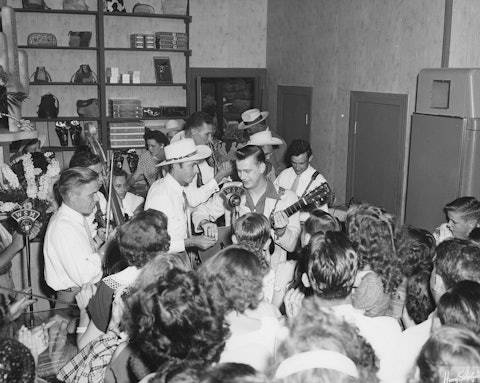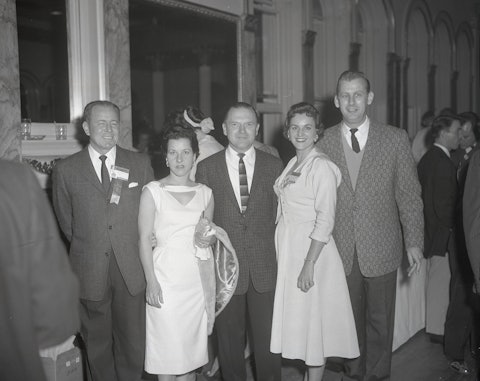George
Morgan

-
Inducted1998
-
Born
June 28, 1924
-
Died
July 7, 1975
-
Birthplace
Waverly, Tennessee
A fixture on the Grand Ole Opry for much of the period from 1948 until his death in 1975, Country Music Hall of Fame member George Morgan possessed one of the smoothest tenor voices in country music.
The Road to the Opry
Born some seventy miles west of Nashville, George Thomas Morgan moved a couple of years later with his family to Barberton, Ohio. At age eleven, he learned to play guitar, and he made early appearances on radio in Ohio at WAKR–Akron and WWST–Wooster. His career gathered momentum on the WWVA Jamboree in Wheeling, West Virginia, during the 1940s.
In September 1948, Eddy Arnold decided to leave the Grand Ole Opry. Morgan, whose singing style was similar, joined the show on September 25, 1948, without benefit of a hit record. Columbia Records had signed Morgan just days before, on September 14, but due to the 1948 musicians’ union strike, he was prevented from recording until January 16, 1949.
Songs
00:00 / 00:00
00:00 / 00:00
00:00 / 00:00
“Candy Kisses” and Other Hits
Recorded at that first session, his composition “Candy Kisses” launched his recording career with a bang, eventually reaching #1 on the country charts. On April 30, 1949, Morgan accounted for half the listings on Billboard’s country Top Ten chart. In addition to his three singles then on the chart—“Candy Kisses” (#2), “Rainbow in My Heart” (#8) and “Please, Don’t Let Me Love You” (#9)—he was represented by covers of “Candy Kisses” by Elton Britt (#8) and Red Foley (#10).
That first year proved to be his biggest on the charts, with six singles ultimately hitting the Top Ten in 1949. Of these, “Room Full of Roses” (#4, 1949) was Morgan’s only record to cross over onto the pop charts (#25).
Videos
“Candy Kisses”
Country Style USA, 1958
“Hello Out There”
Pet Milk Grand Ole Opry, 1962
Recorded at his first recording session, George Morgan’s composition “Candy Kisses” launched his recording career with a bang, eventually reaching #1 on the country charts. On April 30, 1949, Morgan accounted for half the listings on Billboard’s country Top Ten chart.
Photos
-

George Morgan (far left) and others eating Pet-Ritz Frozen Cream Pies, probably in National Life Studio C, 1962. Jim Reeves is third from left. Photo by Elmer Williams.
-

Hank Williams and George Morgan (holding guitar behind WSM microphone) at the opening of Hank and Audrey’s Corral in Nashville, 1951.
-

George Morgan (far right) with WSM announcer Ott Devine (left) and others, probably taken during Grand Ole Opry birthday celebration, sometime 1959-1961. Photo by Elmer Williams.
-

George Morgan (left) and Roy Drusky backstage at the Ryman Auditorium during a broadcast of the Grand Ole Opry, c. 1955.
Later Career
Morgan left the Opry in 1956 to host a TV show on Nashville station WLAC, but he returned to the Opry in 1959 and remained a popular presence there until his death. After seventeen years with Columbia, Morgan left the label in 1965. He moved on to the Starday and Stop labels, and then Decca/MCA in 1971, where he scored his biggest hit in years with “Red Rose from the Blue Side of Town” (#21, 1973–’74). His last recordings were made for 4 Star.
In 1973, Morgan watched proudly when youngest daughter, Lorrie Morgan, made her Opry debut. Sadly, George Morgan died not long after his fifty-first birthday, from complications following open-heart surgery. Through the wonders of electronics, a posthumous father-daughter duet, “I’m Completely Satisfied with You,” charted briefly in 1979.
—Walt Trott
Adapted from the Country Music Hall of Fame® and Museum’s Encyclopedia of Country Music, published by Oxford University Press



